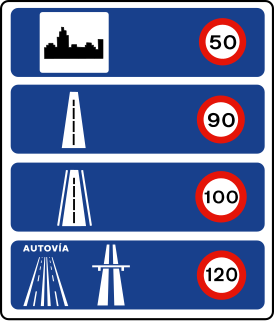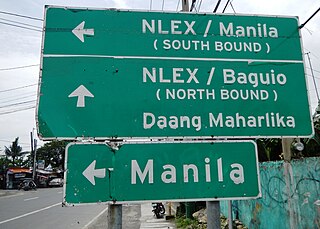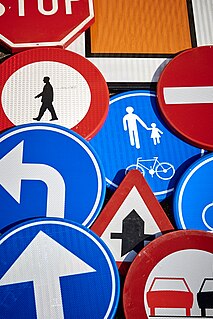This article needs additional citations for verification .(November 2017) |

This article contains guidelines for road traffic in Denmark
This article needs additional citations for verification .(November 2017) |

This article contains guidelines for road traffic in Denmark
In Denmark all driving traffic must use right side lanes. Cars and motorcycles must use low beam light (not parking light) at all times of the day. In a car, all persons must wear seat belt. On motorways and "if necessary" on other roads, turning signal must be used when changing lanes.
Unless signs show other speed limit, the limit is 50 km/h in towns, 80 km/h outside towns and 130 on motorways (shown on signs). Trucks, buses and vehicles with trailers may not go faster than 70 km/h outside towns, except on motorways, where 80 is allowed.
Drivers Licence: A1 and A2 is for small/large motorbike. B is for cars, max. 3500 kg, max. 8 passengers plus driver and a trailer with a max. legal weight of 750 kg. C is for truck over 3500 kg. D is for bus or car over 3500 kg and/or 8 passengers plus driver. E is for trailer over 750 kg. The B/E licence only allows for cars with heavy trailers, even if you have the C and/or D licence. The C/E licence allows for trailer on any vehicle type.
People using rollerskates / -blades are legally categorized as pedestrians and must use pavement. However, skateboards and longboards are not allowed. Riding bikes on pavement is similarly not allowed, but very common. When bikes continue straight ahead in crossroads, they can either be in the right of the right-turn lane or in the right of the straight on lane. Cars must wait until bikes have passed, before they turn right.
Vehicles must stop when pedestrians "obviously intend to cross the road" in a zebra crossing.
Denmark has opportunities to integrate fluctuating energy sources, such as wind and solar power, into the grid and in the transport sector by focusing on intelligent battery systems (V2G) and plug-in vehicles. [1] [2]
As of 2016 [update] there are over 7,000 electric cars in Denmark. [3] Changes in tax exemptions have influenced sales of EVs.

Traffic comprises pedestrians, vehicles, ridden or herded animals, trains, and other conveyances that use public ways (roads) for travel and transportation.

A shoulder, hard shoulder or breakdown lane, is an emergency stopping lane by the verge of a road or motorway, on the right side in countries which drive on the right, and on the left side in countries which drive on the left. Many wider (U.S.) freeways, or expressways elsewhere have shoulders on both sides of each directional carriageway — in the median, as well as at the outer edges of the road, for additional safety. Shoulders are not intended for use by through traffic, although there are exceptions.

In road transport, a lane is part of a roadway that is designated to be used by a single line of vehicles to control and guide drivers and reduce traffic conflicts. Most public roads (highways) have at least two lanes, one for traffic in each direction, separated by lane markings. On multilane roadways and busier two-lane roads, lanes are designated with road surface markings. Major highways often have two multi-lane roadways separated by a median.

A large goods vehicle (LGV), or heavy goods vehicle (HGV), in the European Union (EU) is any truck with a gross combination mass (GCM) of over 3,500 kg (7,716 lb). Sub-category N2 is used for vehicles between 3,500 kg and 12,000 kg (26,455 lb) and N3 for all goods vehicles over 12,000 kg as defined in Directive 2001/116/EC. The term medium goods vehicle is used within parts of the UK government to refer to goods vehicles of between 3,500 and 7,500 kg which according to the EU are also "large goods vehicles".

A passing lane or overtaking lane is a lane on a multi-lane highway or motorway closest to the median of the road. In some countries, lanes are described as being on the 'inside' or the 'outside' of a road, and the location of the passing lanes will vary.
Road signs in Sweden are regulated in Vägmärkesförordningen, VMF (2007:90), and are to be placed 2 metres from the road with the sign 1.6 m from the base for motorized roads. Except for route numbers, there are a maximum of three signs on a pole, with the most important sign at the top. All signs have a reflective layer added on selected parts of the sign as is custom in European countries; most larger signs also have their own illumination.
Driving in the United Kingdom is governed by various legal powers and in some cases is subject to the passing of a driving test. The government produces a Highway Code that details the requirements for all road users, including drivers. Unlike most other countries in the world, UK traffic drives on the left.
Truck classifications are typically based upon the maximum loaded weight of the truck, typically using the gross vehicle weight rating (GVWR) and sometimes also the gross trailer weight rating (GTWR), and can vary among jurisdictions.

The Russian Empire was one of the first countries to create a driving licence. Russia's first licences were issued in 1900 by Saint Petersburg authorities, and Russia joined an international convention in 1909. However, due to relatively small number of cars, the attempts to create a standardised Russian licence were rather sporadic and limited to major urban areas. No comprehensive system of driver licensing was present until 1936, when the Soviet government organised and standardised traffic and driving regulations, with the state-wide system regulated by specialised police authorities.

In the United Kingdom, a driving licence is the official document which authorises its holder to operate motor vehicles on highways and other public roads. It is administered in England, Scotland and Wales by the Driver and Vehicle Licensing Agency (DVLA) and in Northern Ireland by the Driver & Vehicle Agency (DVA). A driving licence is required in England, Scotland, and Wales for any person driving a vehicle on any highway or other "road", as defined in s.192 Road Traffic Act 1988, irrespective of the ownership of the land over which the road passes. Similar requirements apply in Northern Ireland under the Road Traffic Order 1981.

A speed limit is the limit of speed allowed by law for road vehicles, usually the maximum speed allowed. Occasionally, there is a minimum speed limit. Advisory speed limits also exist, which are recommended but not mandatory speeds. Speed limits are commonly set by the legislative bodies of national or local governments.

In Romania the driving licence is a governmental right given to those who request a licence for any of the categories they desire. It is required for every type of motorized vehicle. The minimum age to obtain a driving licence is 18 years. Regardless of age, in the first year after obtaining the licence the driver is called a beginner and has to display on the windscreen and the back window of the car the distinctive sign.

Speed limits in the Czech Republic vary depending on the type of road, and whether the road is within a settlement or not. The top speed limit is 130 km/h (81 mph) for motorways outside of settlements, whereas on regular roads within a settlement the speed limit is 50 km/h (31 mph). outside of the settlement and other than motorway the speed limit is 90 km/h. Various other special restrictions are applied for certain types and weight categories of vehicle.

Spain has different speed limits for every kind of road and vehicle. Until 1973, there were no speed limits on Spanish motorways, a generic limit of 130 km/h was instated then in order to save fuel during the 1973 energy crisis. It was lowered to 100 km/h to prevent accidents, but it was raised again in 1992, this time to 120 km/h. There have been proposals to raise the speed limit to 130 km/h, but have been rejected so far.
Traffic signs, installations, and symbols used in Germany are prescribed by the Road Traffic Regulation (StVO) and the Traffic Signs Catalog (VzKat).
Road signs in Ukraine are governed by a combination of standards set out by the Vienna Convention on Road Signs and Signals, the European Union, and Ukraine Transport and Roads Agency. Ukrainian signs are similar to the signs of post-Soviet states and are set out in 7 separate categories based on meaning: Warning, priority, prohibitory, mandatory, information, guide, and additional plates.

In Spain the driving licence is a governmental right given to those who request a licence for any of the categories they desire. It is required for every type of motorized vehicle. The minimum age to obtain a driving licence is: 16 years for a motorcycle, 18 years for a car, and 21 years for buses and cargo vehicles.

Terminology related to road transport—the transport of passengers or goods on paved routes between places—is diverse, with variation between dialects of English. There may also be regional differences within a single country, and some terms differ based on the side of the road traffic drives on. This glossary is an alphabetical listing of road transport terms.

Road signs in the Philippines are regulated and standardized by the Department of Public Works and Highways (DPWH). Most of the signs reflects minor influences from US and Australian signs, but keeps close to the Vienna Convention on Road Signs and Signals as an original signatory.

This page lists the traffic signs used in Belgium, as included in the traffic code.